2019 Vol. 54, No. 3
Display Method:
Face Stability of Shield Tunnel in Sandy Cobble Stratum with Continuum-Based Discrete Element Method
2019, 54(3): 499-506, 586.
doi: 10.3969/j.issn.0258-2724.20170406
Abstract:




 Advance Search
Advance Search
 Email alert
Email alert RSS
RSS [Abstract]
[Abstract] [FullText HTML]
[FullText HTML] PDF 1223KB
PDF 1223KB Supplements
Supplements [Cited By]
[Cited By]